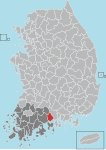Gwangyang-eup
This is your travel guide for Gwangyang-eup, Gwangyang, Jeollanam-do, South Korea
1 : Suncheon Bay Garden Expo Park [2 hrs]
Explore the beautiful Suncheon Bay Garden Expo Park, which boasts a variety of themed gardens and exhibits. Take a leisurely stroll through the colorful flower gardens or enjoy a boat ride on the picturesque bay. Don’t miss the famous “Time Sculpture” of the expo park, a symbol of the region’s commitment to environmental conservation.
2 : Odongdo Island [2 hrs]
Visit the stunning Odongdo Island known for its rugged coastal scenery and diverse flora. Take a walk along the coastal trail lined with vibrant camellia flowers and enjoy panoramic views of the surrounding sea. Be sure to visit the iconic lighthouse for a unique perspective of the island and its surroundings.
3 : Ungcheon Beach [1 hr]
Relax on the sandy shores of Ungcheon Beach and soak up the sun in a tranquil setting. Enjoy a swim in the clear waters or try your hand at various water sports such as snorkeling and windsurfing. Take a leisurely walk along the promenade and savor some local seafood delicacies at nearby restaurants.
4 : Gwangyang Maehwa Village [2 hrs]
Discover the charm of Gwangyang Maehwa Village, famous for its stunning blooming plum blossoms in spring. Take a stroll through the quaint village dotted with plum trees and traditional hanok houses. Visit the Plum Blossom Festival held annually to celebrate the beauty of these delicate flowers.
5 : Seonamsa Temple [2 hrs]
Explore the serene Seonamsa Temple, nestled in the picturesque Jirisan National Park. Admire the intricate architecture of the temple buildings and soak in the peaceful atmosphere of the surrounding forests. Don’t miss the opportunity to participate in a temple stay program to experience the daily life of Buddhist monks.
Background Info
Weather
In Gwangyang, the average temperature ranges from 0°C to 30°C throughout the year. It experiences moderate rainfall, with the rainy season typically occurring from June to September. Humidity levels can be high, especially during the summer months. Air quality is generally good, but it can vary depending on industrial activities in the region.
Language
Korean is the local language spoken in Gwangyang, with English being less commonly used. Basic knowledge of Korean phrases can be helpful when interacting with locals and navigating the area.
Cost Of Living
The cost of living index in Gwangyang is relatively moderate compared to other cities in South Korea. Prices for accommodation, dining, and transportation are affordable, making it a budget-friendly travel destination.
Other
Gwangyang is known for its thriving agricultural industry, particularly in the production of plums and bamboo. The region’s natural beauty and cultural heritage make it a popular destination for both domestic and international tourists.
Gwangyang – city of Jeollanam-do, South Korea
Location: Gwangyang-eup, Gwangyang, Jeollanam-do , Korea (the Republic of)![]()
Official Site: Visit Official Site
Summary: Gwangyang Summary
Map: Map of Gwangyang
Weather: Gwangyang Forecast
Population: 144,414 (2015)
Area: 458.89 sq km
Coordinates: 34.94, 127.702
Timezone: (UTC+09:00) Korean Standard Time (Seoul)


